Research for whom?
Reflexivity, one of those words that we understand the meaning, but with each experience and exercise of observing and questioning oneself more layers it gains, and so it has been throughout the trajectory of this researcher.
The writing of the thesis project is a challenge, not only for the theory and the theme, but especially for the methodology. It is expected that in the doctorate the person will be able to structure more quickly his research project, as well as its execution since he dedicated two years in the master’s degree to learn and evolve these questions.
However, when Cartography is presented as a methodological choice, everything is called into question. The way of writing, the object, the objective, the audience to whom the text is intended. There is a multiplicity of theses and dissertations that make use of cartography, many report their methodological path in detail, the experience of the researcher in transiting through it, their doubts and their exercise of reflexivity.
But how to report the beginning of the journey? How to report the project, how to design a course in a methodology that has as its characteristic the opening and construction with the field? How to translate this look, this care, this reflexivity into a thesis project?
In this sense, I ask myself: for whom am I writing this thesis project? In addition to fulfilling a requirement of the doctoral program, what are my goals in this writing? Who is the audience that will read? Do I write to the 3 teachers who will participate in the panel only? Do I write to advance my project? Do I write for someone who might be interested?
If the thesis will be written with the actors of the research and for people who are interested in the topic, it seems to me that this thesis project should be written for them. An invitation, an explanation, a description, a compilation of some of the readings organized in order to help give meaning to the moment we live, the challenges we face, the contradictions present.
A narrative that is able to inform, share a worldview and invite to a journey of learning and transformation of reality.
Movement
Jorge Drexler speaks of a species traveling without belongings, Dylan wonders about how much we still need to walk, Cartola alerts to the little of life that escapes at every corner. Be it the “Pink-Floydiano” tic-tac, Gil’s avocado tree, Chico’s wheels, and so many others that have passed by. The fact is that, inexorably, we are being dragged through space-time.
Bowie in “Changes,” Lennon and McCartney in “Strawberry Fields Forever” spoke of the infinite possibilities, of the realities that occur at the same time modified by the observer’s point of view. The connections of chance and serendipity are fundamental elements in the literary constructions of Dostoevsky, or in the extrapolations of Kafka and Borges. Evidenced in the total vision of “The Aleph”, but Borges highlights it especially in the great contradiction of “Funes, el memorioso”.
Funes, a masterful character created by Borges, has a special characteristic: his total memory, able to remember everything, every second, every detail. He easily learned English, French, Latin, but there is the suspicion that he was not very capable of thinking, to which he adds in the book: “To think is to forget differences, it is to generalize, to abstract. In the crowded world of Funes there were but details, almost immediate.”
Beyond artistic genius, this preamble was made to draw the parallel about the challenges of living in a complex world, awash with information and possibilities. In which abundance can, paradoxically, paralyze, and induce the search for forms of anesthesia to avoid the discomfort of uncertainty.
I can say that this has been my movement-generating question:
How can I embrace complexity without paralyzing myself?
Figure 1 – Free representation of a timeline that includes this study
 Table Automatically generated description
Table Automatically generated description
-

Turning “or” into “and”
The complexity of a situation can be seen as being greater the more elements or variables it has. But it’s not just the amount of elements that matters, but also how they relate or interact with each other. It’s the difference between adding things up, multiplying them, or elevating them to power. That is, it is not only what we have, but also how these things combine or influence each other that makes a situation more complex.
Translating into natural language, we could say that it is the difference between recognizing the influence of multiple factors on a reality and using the conjunction “and” instead of the disjunction “or”. This implies an approach that not only recognizes the multiplicity of influences, but also the interconnectedness and interdependence between them.
This understanding solidified during my one-year immersion experience at Team Academy Finland in 2009. It was there that I experienced the reality of paradoxes, such as: learning and working simultaneously; fun and seriousness, research and apply the knowledge acquired; to evolve individually through the collective; to collaborate and be pragmatic. The list goes on, but the bottom line is that these experiences have shown me that complexity doesn’t have to be paralyzing. On the contrary, it can be a source of richness and diversity.
Failing miserably
In 2010 the continuity plans in Finland are interrupted to return to Brazil and support the family business that maintained society, a plastics recycling industry.
Convinced of the newly lived experience, I applied a clumsy attempt at something similar to that experienced in Finland, with the company’s production teams, I failed miserably.
After we closed the company, I took part in many initiatives, including movements in search of financial sustainability, business hypothesis tests and professional discoveries, for two years I implemented a learning initiative by projects for high school students of a school in Porto Alegre, along with training in organizations and for teachers of higher education.
In 2016, in search of a theoretical framework, structure and method, I researched in my master’s degree what is the impact of the implementation of project-based learning to teach sustainability to students of the UFRGS administration course.
In a tweet, I can say that the method is a potential driver for people already converted. Although 85% of the participants highlighted the need to have active learning methodologies and practices in the teaching-learning process in the course curriculum. We could verify a high impact of the method in 25% of the participants, 50% went through the process and had some kind of transformation in their practices and worldview, and 25% were resistant to the proposal (GONZALES, 2018).
-

Turning “or” into “and”
The complexity of a situation can be seen as being greater the more elements or variables it has. But it’s not just the amount of elements that matters, but also how they relate or interact with each other. It’s the difference between adding things up, multiplying them, or elevating them to power. That is, it is not only what we have, but also how these things combine or influence each other that makes a situation more complex.
Translating into natural language, we could say that it is the difference between recognizing the influence of multiple factors on a reality and using the conjunction “and” instead of the disjunction “or”. This implies an approach that not only recognizes the multiplicity of influences, but also the interconnectedness and interdependence between them.
This understanding solidified during my one-year immersion experience at Team Academy Finland in 2009. It was there that I experienced the reality of paradoxes, such as: learning and working simultaneously; fun and seriousness, research and apply the knowledge acquired; to evolve individually through the collective; to collaborate and be pragmatic. The list goes on, but the bottom line is that these experiences have shown me that complexity doesn’t have to be paralyzing. On the contrary, it can be a source of richness and diversity.
Failing miserably
In 2010 the continuity plans in Finland are interrupted to return to Brazil and support the family business that maintained society, a plastics recycling industry.
Convinced of the newly lived experience, I applied a clumsy attempt at something similar to that experienced in Finland, with the company’s production teams, I failed miserably.
After we closed the company, I took part in many initiatives, including movements in search of financial sustainability, business hypothesis tests and professional discoveries, for two years I implemented a learning initiative by projects for high school students of a school in Porto Alegre, along with training in organizations and for teachers of higher education.
In 2016, in search of a theoretical framework, structure and method, I researched in my master’s degree what is the impact of the implementation of project-based learning to teach sustainability to students of the UFRGS administration course.
In a tweet, I can say that the method is a potential driver for people already converted. Although 85% of the participants highlighted the need to have active learning methodologies and practices in the teaching-learning process in the course curriculum. We could verify a high impact of the method in 25% of the participants, 50% went through the process and had some kind of transformation in their practices and worldview, and 25% were resistant to the proposal (GONZALES, 2018).
Figura 2 – Particionamento do conhecimento
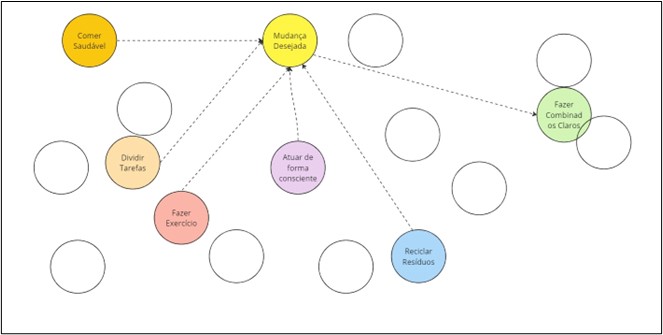
Fonte: Autor
-

De pontos para nós – “From dots to knots”
This history of dividing things began with Newton and Galileo in the so-called Scientific Revolution of the seventeenth century, when they began to describe the natural world in terms of universal physical laws. This approach was extremely important for humanity, since then the world GDP has grown steadily over the last three centuries. According to the website Our World in Data (“Economic Growth – Our World in Data”, 2023), GDP per capita has increased more than 20-fold since the independence of the United States in 1776 until 2018.
Figure 3 – GDP per capita growth by country
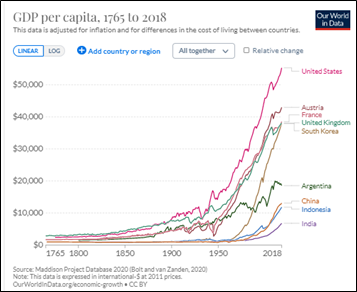
Graph Automatically generated description with medium confidence
At a time when computing power was limited, it was necessary to break down problems to make them more manageable. Today, with the evolution of technology, we have the ability to create more complex models that respect the interdependence between systems and their variables. Most importantly, we can rethink the role of people in this context.
In the age of mechanization, especially when technology was still incipient, people were seen as substitutes for machines that did not yet exist. The idea of treating people as resources, as proposed by Taylor and Fayol in scientific management, was prevalent.
In this historical context, research theories and methodologies were shaped by a worldview that saw people as resources. They were classified, categorized as objects of study and considered replaceable (Engeström, Sannino & Virkkunen, 2014). The thinking was guided by broad guidelines that were to be unfolded and implemented in the organization.
Today, although we still see the influence of these currents of thought, we have the opportunity to rethink these premises. We can value the unique and irreplaceable role of people, both in the organizational logic and in the premises of the research that is conducted. This represents a significant shift in the way we approach management and research, putting people at the centre.
One of the approaches that aligns with the reframing of the role of people is Cartography. Cartography, a research methodology inspired by Deleuze and Guattari and developed by researchers such as Virginia Kastrup and Regina Benevides de Barros, is an approach that seeks to map territories and understand processes. It focuses on the subjective experience of the individual and understands reality as constantly changing and flowing. Instead of seeking universal truths, cartography explores the multiplicity and complexity of situations (KASTRUP; STEPS, 2013).
In my personal interpretation it works as an operating system, able to add applications (tools and strategies) to it according to the needs of the research and the conditions of the territory that is being found. An operating system that understands the world as complex, interconnected and interdependent and of situated knowledge.
-

Tecendo uma rede
Incluir muitos elementos em uma análise pode ser desafiador, em especial quando essas variáveis são subjetivas, interpretáveis e em constante mudança, como parte das capturadas através da cartografia.
Figura 4 – Representação gráfica da tese
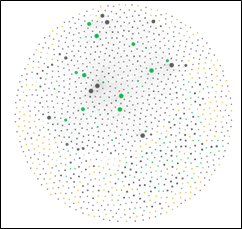
Fonte: Autor
In Figure 4, we present a graphic representation of 816 files, which include references, transcriptions, documents, figures and texts of various natures and functions. These elements, when ordered, classified, and related to each other, form paths, connections, and nodes of a specific network. This network is visually represented in Figure 5.
Figura 5 – Representação gráfica da tese com conexões
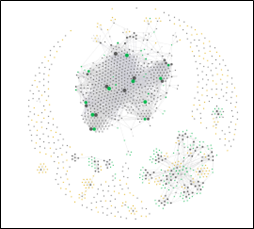
Fonte: Autor
These images were generated by the Obsidian program, which I adopted as a management and organization system for the data and information used in the Thesis.
-

Recursion and reflexivity
The sequence of topics presented in this section follows a logical rather than chronological formatting. We can understand the process of construction of the thesis as shown in Figure 6.
In Figure 6, we can see areas of interest highlighted. These were explored theoretically and empirically in a recursive way. Thus the particular connections of this study were established: between Hybrid Organizations, Cartography (methodology) and Theory of Historical-Cultural Activity (theoretical lens).
Figura 6 – Meta processo Tese parte 1
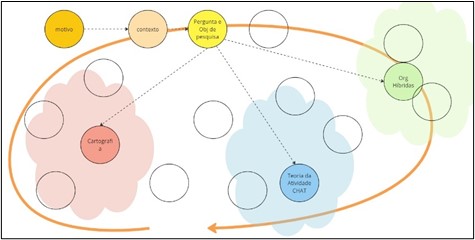
Fonte: Autor
A recursividade permite a construção do conhecimento situado e em camadas. Possibilitando a constituição de conexões, conteúdos e construções teóricas que funcionam como pontes entre os pontos de partida.
Figura 7 -Meta processo Tese parte 2
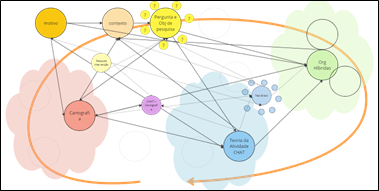
Fonte: Autor
Depois de passar pelo contexto e histórico, assim como o porquê da metodologia escolhida, é hora de conhecermos as lentes usadas para “ordenar o caos”.
-

Many “coincidences” brought me closer to the Theory of Historical-Cultural Activity (CHAT)
It is known and notorious in the academic corridors the effects that a theory can exert on a researcher. Some symptoms of this academic passion may include: a) the attempt to justify everything with the chosen theory; b) the need to talk about it all the time; c) the tendency to criticize other theories.
It can be said that these behaviors are characteristic of a passion, which can arise for different reasons. However, one thing is certain: a passion is not understood through reason alone. In our case, we were introduced during the master’s degree. When designing a possible approximation, I was promptly alerted to its complexity, difficulty of application, and depth. Driven by reason and the tight deadlines of the master’s degree, we avoided ourselves.
At the beginning of the doctorate, and living the results of the master’s degree described above, CHAT appeared again as a personal challenge, and possibility of instilling theoretical robustness in the new exploration. Some interesting coincidences about CHAT and Team Academy.
The main theorist and exponent of CHAT is called Yrjö Engeström, a Finnish researcher who in the 90s, faced with the economic crisis that Finland was going through, built a model of application of the Theory of Activity for Organizations, called the Laboratory of Change (ENGESTROM, 2014).
The founder of Team Academy, is called Johannes Partanen, Finnish marketing professor who in the 90s, faced with the economic crisis that Finland was going through, built a model of learning by practice, applied in the teaching of Business Administration, called Tiimiakatemia.
The aspect that strikes me most is the cross-influences on the propositions. While Team Academy proposes to join entrepreneurship with cooperativism, influences coming from very different schools of thought.
Engeström, sought in Russian social psychology to look at the collective through the concept of Activity and the adoption of Marxist dialectics. His book “Learning by expanding” where he proposes the bases of the Activity Theory used today is from 1987, two years before the fall of the Berlin Wall.
CHAT understands that an Activity System is part of an interconnected and interdependent network of Activity Systems. The theory can be applied in a restricted framework, but it is also able to include other levels of analysis, and the relationships between them. I highlight 3 more points based on Engeström (2014):
-
CHAT is able to capture, order, translate and analyze processes, with a simple visual representation;
-
It values multivocality, constant flow and considers learning as a social process
-
Understands the researcher as an agent of influence and transformation, adopts the interventionist research approach
-

Historical-Cultural Activity Theory (CHAT) to order chaos
The speed of change, accelerated by technology is dizzying, the VUCA, the BANI, the Startups, Starlink, Virtual Reality, Unicorns, “farialimers” … and ChatGPT.
I will use ChatGPT as a revolutionary tool of an Activity System to exemplify the use of CHAT for the reader. Let’s look at the impact of ChatGPT on Higher Education, specifically on how the Academy is evaluated and rewarded, and the impacts of this new tool.
Brief preamble:
There is a recurring critique of the way academia, especially organizational studies—which encompasses management research within the larger area of applied social sciences—is conducted. The criticism focuses on the search for academic productivism, where researchers are pressured by the number of articles published and their impact (SILVA, 2019).
To put it simply for the non-academic reader: academic research people are evaluated by the quantity of articles they produce and the impact of those articles, which should be a quality metric, but it has been widely debated whether it is the best approach. The purpose of these metrics is to make academic production more relevant, with the premise that high production will result in quality. Perhaps there is an intention to make visible the work of research people, which is often invisible to the eyes of society (DE FARIAS JÚNIOR, 2020).
Metrics are used to evaluate female professors, courses, and universities. They influence the resources allocated to each institution, and to the researchers. Thus, with the definition that producing was necessary, the internal processes of the Universities were adjusted for this purpose. In some cases, generating creative forms of production of articles (VIEIRA; CASTAMAN; JUNGES JUNIOR, 2021).
In December 2022, ChatGPT was launched, an artificial intelligence model capable of producing complex and contextually relevant texts. It has been trained on a wide range of internet data, and is able to perform tasks such as answering questions, writing essays, summarizing texts, translating languages, and even generating creative ideas (DWIVEDI et al., 2023).
Quickly a number of applications, plugins and functionalities were released, and demonstrated the potential of the tool in replacing many of the tasks performed by humans today. Just as automation has done with repetitive work in industries and mechanization has taken women workers out of the field, artificial intelligence tends to impact knowledge workers and the academic world (BERG, 2023).
-
The introduction of a new tool is capable of destabilizing the Activity System
When we lack a theoretical lens to examine a phenomenon, it is common to oversimplify the discussion or increase complexity to paralysis or misunderstanding. We see this happening frequently on social media, and unfortunately simplification is much easier to absorb and replicate.
Figure 8 – Multiple variables in the analysis of a phenomenon
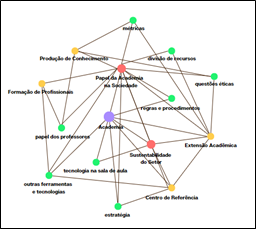
Chart, Radar chart Automatically generated description
The Cultural-Historical Activity Theory (CHAT) proposes that an Activity System is composed of six interconnected components:
-
Subject: A person or group that is performing the activity. In the context of academia, the subject would be the researcher or the research group.
-
Artifact: the tools or signs that the subject uses to perform the activity. In the case of ChatGPT, the software itself would be the artifact.
-
Object: The goal or purpose of the activity. In academia, the object could be the production of knowledge or the publication of a research article.
-
Rules: The norms or guidelines that govern the activity. In the academic context, the rules could include publication guidelines or research evaluation criteria.
-
Community: The social group that shares the same object. In academia the academic institution and the parties involved.
-
Division of Labor: The way tasks are distributed among community members. In academic research, the division of labor can vary greatly depending on the size and structure of the research group.
These six components interact to create a seventh element: the Result. The result is the end product of the activity, which, in the case of academic research, could be new knowledge or a research publication.
By applying this framework to analyze the current situation of academia with the introduction of ChatGPT, we can begin to understand how this new tool is affecting each component of the Activity System (SA) and, by extension, the end result. First we will build an SA representing, in a simplified and general way, how the process of academic production is configured today in a Higher Education Institution in Brazil.
Figura 9 – Sistema de Atividade do fazer acadêmico pré ChatGPT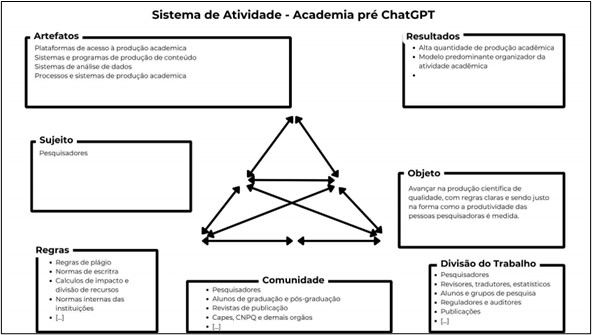
Fonte: Autor adaptado de Engeström (2001)
Este exercício desempenha algumas funções importantes:
- Ilustra que a produção de um Sistema de Atividade (SA) é uma interpretação da pessoa pesquisadora sobre o fenômeno em estudo
-
Revela a fragilidade do equilíbrio dos SAs
Figura 10 – Sistema de Atividade do fazer acadêmico pós ChatGPT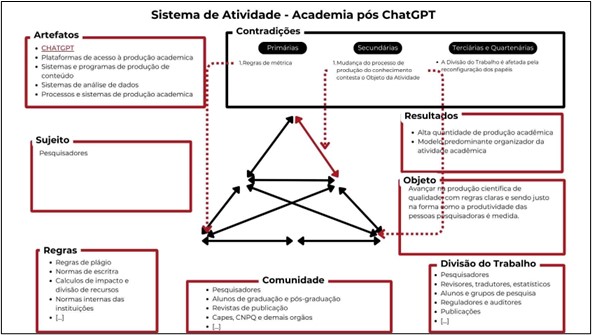
Fonte: Autor adaptado de Engeström (2001)
In Figure 10, we see a new picture called “Contradictions,” and dotted red lines indicating some prominent areas. This analysis highlights the contradictions present in the SA. Contradictions are the engine of development and evolution of an SA. In many cases, they are already present, but they do not have the strength to change the system. In this case, for example, dissatisfaction with the way to measure productivity already existed among the researchers, but until now it has not had enough force to force an evolution in the AS (ENGESTRÖM; SANNINO, 2010).
This is potentially the situation where a new artifact destabilizes the balance of the AS and requires an evolution. In this case, forcing a complete review of academic practice, from the Object (the raison d’être of this system), through the artifacts that will be used, the rules that will be redefined, the division of labor that will be reconfigured, and so on (DWIVEDI et al., 2023).
CHAT, in this case the Activity Theory, understands SA as interconnected parts of other SA’s. This view allows us to increase or decrease the “zoom” of analysis of an SA, depending on the phenomenon to be researched, for a better understanding of the research object and its interrelations (VIRKKUNEN; KUUTTI, 2000).
Figura 11 – Exemplo de um (SA) com interrelações 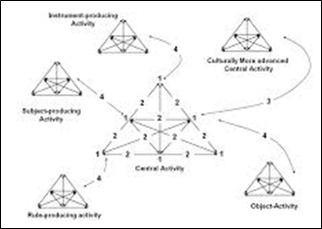
Fonte: Engeström (2001)
In Figure 11, we have an AS with interrelations, because we can represent parts of the AS as an independent SA. For example, the process of reviewing an article, which can be represented as an artifact, can be investigated as a complete SA. This ability to approach and distance from the object of study allows Activity Theory to build a more systemic understanding of phenomena, maintaining a common analysis structure.
-
Reflections of the “mini practice”
We made a small cycle of steps that aimed to guide the non-academic reader, especially in relation to the premises adopted by me. I used a didactic framework to illustrate the recursive nature of research, which gains depth as the elements get closer and new connections become possible, all underpinned by the reflexivity of the researcher.
We highlight the crucial role of clear contextualization, supported by a robust methodology and artifacts that provide the necessary conditions for the operationalization of research. In addition, we emphasize the importance of the theoretical lens in the organization of a phenomenon that might otherwise be considered excessively complex for study.
As is common in any study, we come to the end with more questions than when we started, each of them born from reflection on the journey we have traveled. In this case, it’s no different. I conclude this constructive introduction with a question that naturally arises:
Will universities need to redefine their role in the Age of Artificial Intelligence? If so, what will this new role be?
I believe that one of the fronts that should gain strength is related to the role of helping, people, groups, organizations to create meaning and situated application to the knowledge produced in conjunction with Artificial Intelligence. That aligns with the positioning of Activity Theory and Cartography to understand the researcher as an interventionist (CASAGRANDE; GODOI, 2013; STEPS; KASTRUP; FROM SCOSSIA, 2015).
Perhaps threatened by “silicon brains” we can finally implode the academic ivory tower and move closer to phenomena, society and intervention for transformation.
-
Sustainability and the role of organizations
The search for ways to organize and learn, which enable a more sustainable future and can develop the human potential of the employees of an organization is an urgent path and without a known end, essentially because they are two concepts (or objects of activity) based on purpose and not on goals.
Although we have difficulty looking at these issues analytically, because it gives us a feeling of inability to act, it is known that we live in a world in unbalance in an unsustainable way (UN, 2015). We are heading for a catastrophe of our species, where the environmental issue is the one that gains the most notoriety, but we also face crises: in international justice (trade and immigration); global justice (poverty and human rights) and the whole ecological issue (species extinction, ocean acidification, global warming, etc.)(SHOVE, 2010; White, 2018).
Shove (2010) argues that the transition to sustainability does not depend on legislators forcing the population to transform their habits through sacrifices, instead the transition occurs when “the rules” of the game cease to apply and the status quo is questioned. It is perhaps too early to say that it is this movement that we are experiencing, but some signs that a redefinition is underway are apparent, such as the repositioning of the Financial Times editorial line, calling for the capitalist model as we know it to be rethought.
Organizations have a fundamental role in building viable solutions so that we are able to face the challenges that lie ahead as humanity (UN, 2015). This call of the UN (2015) is even more explicit from the 2030 agenda, which organizes the challenges and goals related to sustainability in the 17 Sustainable Development Goals (SDGs).
In recent years we have seen some business movements promoting a new look at our way of living, producing and organizing and in this work I will focus on the ways of organizing. One can highlight Conscious Capitalism, B Companies, Humanized Companies, Restorative Cultures among other organizational movements that seek a transformation of the role of organizations. In August 2019, a group of 200 CEOs of large organizations went public to make a statement that it is necessary to redefine the purpose of corporations for “an economy that serves all Americans” (SANDLER, 2019).
It is relevant to look at these movements, not in isolation, but as part of the process of redefinitions that are occurring on different fronts, forms, intensities and social groups. Our development model is environmentally unsustainable (WWF, 2019), the way it is done, promoting the concentration of resources, and the proliferation of misery is a crime against humanity (BBC, 2019). However, discussions arising from the aforementioned movements mirror mechanistic thinking, polarizing and radicalizing the debate in order to maintain the status quo (WHEATLEY, 2011). Or whether it’s blue or red; or A, or B. As raised by the newspaper El País, “we do not have the capacity to discuss politics” (EL PAIS, 2019).
We are living a populist/conservative wave and we do not know how to deal with it, the emblematic example is the denial of climate change and the inability of the scientific community and the media to respond to this phenomenon (COOK; COOK, 2016), not to mention the politicization surrounding the novel coronavirus (COVID 19) pandemic. Add to this our inability, as a society, to accept the contradiction and the lack of definitive answers to complex problems (SCHNEIDER, 2015). Schneider (2015) points out that the denial of paradoxes is a widespread aspect in our society, due to the inability to feel “groundless”.
The author uses the expression “groundless” to explain times when we lose our references, or understandings of absolute truths. And as a society, we end up buying simplistic and comforting solutions (SCHNEIDER, 2015).
Engeström (2014) reports a similar phenomenon in expansive learning processes, where people unable to construct a proposal for the contradiction faced in an activity, end up disqualifying the problem and retroacting in the evolutionary process.
We do not know, as a society, how to deal with the subject and neither do the organizations. The book Reinventing Organizations by Frederick Laloux became a reference in the search for new ways to organize. From the studies of Ken Wilber, the author presents a model of understanding the different levels of maturity of individuals that are reflected in corresponding organizational modes. Seeking to offer clarity of his pedagogical intention, Laloux proposes an adjective and a color for each evolutionary stage of his model (LALOUX, 2017).
Figura 12- Estágios da consciência humana e organizacional
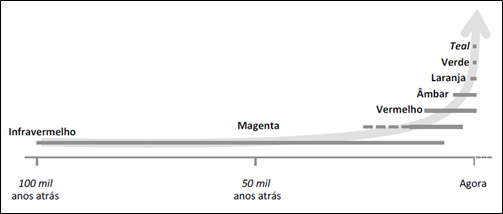
Fonte: Laloux (2017, p.34).
Laloux (2017) details in his book the stages of consciousness, their relationship to organizational types and characteristics of each of these types of organization. It follows the logic that the forms of organization could evolve and resignify the roles of the participants of these organizations. In the table below I systematize the main characteristics of the organizations according to the author’s classification.
Table 1 – Stages of consciousness
|
Current examples |
Key Advances |
Guiding metaphor |
|
|
Red Organizations
|
-Mafia – Street gangs – Tribal militias |
– Division of labor – Command authority |
Pack |
|
Amber Organizations
|
– Catholic Church -Armed forces -Most government agencies – Public school systems |
-Formal roles (stable and scalable hierarchies) -Processes (long-term perspectives) |
Armed forces |
|
Orange Organizations
|
– Multinational companies – Autonomous schools |
-Innovation –Accountability -Meritocracy |
Machine |
|
Green Organizations
|
– Culture-driven organizations (Examples: Southwest Airlines, Ben & Jerry’s) |
– Empowerment – Culture value-driven – Stakeholder model |
Family |
Source: Laloux (2017, p.34).
The ordering by colors and stages of evolution is not related to people, but rather to the organizational culture present, “If we look at the structure of an organization, its practices and its cultural elements, we can usually discern from what worldview they derive.(LALOUX, 2017, p. 40)”.
There is nothing particularly new in its proposition, but it compiles and translates in an accessible and didactic way, these stages of organizational consciousness. Proposing a series of caricatured models facilitates the understanding and absorption of his ideas to the general public, the author launched the book in 2014 and has become a reference in the difficult task of individuals to be able to express the kind of transformation needed in organizations. More than changing isolated discourses and actions (DIGNAN, 2019), a transformation of practices and the way of seeing the world is necessary (LALOUX, 2017).
The main banner of the “TEAL paradigm” is the expression of the human potential of all the people collaborating in an organization. This ideal is expressed in three values: evolutionary purpose, integrality and self-management (LALOUX, 2017).
-
Visualizing Laloux’s proposition from CHAT
In Chart 2, we can see an exploration of the levels of consciousness proposed by Laloux, seen from the lens of Activity Theory, important to highlight some points:
-
Organizations can generate the same product from very different logics and processes
-
The Object is the reason for the existence of the Activity System, the Object evolves along with the increasing complexity of the Organization
-
Subject and Artifacts also evolves towards greater inclusion and autonomy of the actors of the Activity System
-
The Community expands, including customers, the production chain and society as a whole
-
The Division of labor also reconfigures itself, adjusting to the Object, the Artifacts, the Rules, the Community and the Subjects involved
We can understand that even if the result or product remains apparently the same, the entire Operating System reconfigures itself. The evolution of consciousness of an organization is not a superficial change, or one that can be defined by a group and a simple key is turned. In the course of this Thesis we will explore this journey.
We observe the necessary transition of organizations from hierarchical structures to the formation of autonomous teams as an essential strategy to deal with the complexity of the system (organization) and the environment that is inserted. As organizations move into the green and TEAL stages of consciousness, the autonomy and decision-making power conferred on teams increases. The reason for this is that in a complex and ever-changing environment, decisions often need to be made quickly and at the level where the work is being done, aka “at the tip.”
The team-based structure allows organizations to be more agile and resilient, adapting quickly to changes and responding effectively to new demands. This also empowers team members to use their knowledge and skills for decision-making, increasing engagement and job satisfaction.
Table 2 – Systems of Activity of an Organization at different levels of consciousness
|
Stage of consciousness |
Result |
Object |
Subject |
Artifacts |
Menstruation |
Community |
Division of labour |
|
Red Organizations |
Furniture Production |
Simple furniture, mass production |
Workers |
Hand tools, rudimentary equipment |
Boss-imposed hierarchy, tight control, discipline |
Boss and workers |
Work divided by the boss in an authoritarian way |
|
Amber Organizations |
Furniture Production |
Best quality furniture, limited variety |
Supervisors, Workers |
Simple industrial machines, standardized production processes |
Formal rules, standard procedures, command and control |
Supervisors, workers, suppliers, customers |
Work divided according to well-defined functions, following hierarchy |
|
Orange Organizations |
Furniture Production |
Custom furniture, diversified line |
Managers, Workers, Innovation Teams |
Advanced industrial machines, digital tools for innovation and efficiency |
Clear goals and objectives, meritocracy, incentivized innovation |
Managers, innovation teams, workers, suppliers, customers |
Work divided by skills, encouraging innovation and accountability |
|
Green Organizations |
Furniture Production |
Ecological, sustainable furniture, production with low environmental impact |
All members of the organization |
Green technologies, eco-efficient processes, collaborative management tools |
Ethical and sustainable values, democracy in the workplace, empowerment of women workers |
All people in the organization, ethical suppliers, conscientious customers |
Work divided collaboratively, flexible and adaptable roles, prioritizing job satisfaction |
|
TEAL Organizations |
Furniture Production |
Transformational furniture that adds value to people’s lives, creates social well-being and minimizes environmental impacts |
Everyone in the organization |
Advanced technologies, adaptive processes, collective intelligence |
Absence of fixed rules, flexibility and adaptation, orientation by purpose |
All the people in the organization, the entire value chain, society |
Self-organization, fluid and rotating roles, based on individual needs and potentialities |
Fonte: Autor
-
From hierarchical organizations to teams:
The orientation of work by teams has been gaining more attention, not only in Laloux’s propositions, but also is the organizing logic of agile methodologies (LEMAY, 2019). Being applied in many ways in different situations, in a recent publication the World Economic Forum points out how agile methods are being adapted to the boards of large corporations (WORLD ECONOMIC FORUM, 2018).
It is very common to confuse what is a team with a work group, the fundamental difference lies in the way the work is measured, which in turn influences the entire dynamics employed. A working group is composed of a group of people who share an objective and are coordinated by a leadership, but have their performances individually monitored and evaluated. On the other hand, a team is “composed of a small number of people with complementary skills committed to a common purpose, goal setting, and the approach and metrics that will make them mutually responsible” (KATZENBACH; Smith, 1993, p. 112).
The adoption of teams is not a new practice, it has just been reshaped with new technological tools, techniques of project management models, and workflow organization. Even the concept of self-managing or self-directed teams is not new, the first known study of self-directed teams was conducted in the United Kingdom and published in 1951, at the time it was a self-directed team for coal extraction in the longwall method (TRIST; BAMFORTH, 1951).
Like Elton Mayo’s experiment at Hawthorne, considered the founder of the school of human relations, the adoption of self-managing teams is widely applauded and, at the same time, much criticized. Druskat and Pescolsolido (2002) show that the movement of empowerment of the teams, enables the development of new leaderships, the expression of the technical capacity of the team members, advancement in the communication and decision-making capabilities of the teams, as well as also show the reduction of management positions and the increase of responsibility and accountability of individuals in the execution of their tasks.
With the exclusion of supervisory positions, the organization relies on the peer pressure process, that is, peer pressure begins to guarantee the performance and quality of the group members, thus being able to suppress the intermediate hierarchical levels without prejudice to performance (DRUSKAT; PESCOSOLIDO, 2002). The authors point to the mental model of the team members as a preponderant point for the success of the enterprise, as well as the organizational culture present since the teams have a two-way path in their exchanges with the organization.
The centrality of the user and the high speed in the technological and market evolution make organizations need to bring their teams – autonomous and multidisciplinary – closer to the development and decision-making processes. Justifying the adoption of teams as a model of division of labor, especially in organizations of a more technological character (DIGNAN, 2019).
When multiple capabilities are needed, teams are best suited because of their ability to cooperate, because they are autonomous, and because they are able to learn fast and change fast. Their capacity for analysis and criticism, which goes beyond the technical aspects, makes them capable of innovating through decision-making in paradoxical situations and by unknown paths. They need to have proactivity and rebelliousness of an entrepreneur, even being within an organization (DIGNAN, 2019).
The process of building autonomous teams is a challenging project of radical transformation, with major conflicts of interest, power relations involved in the process and usually not treated transparently. Dignan (2019) highlights some dimensions such as: a) autonomy; b) combined for distribution and work flow; c) forms of power sharing and decision-making; d) learning processes and updating of clear processes; e) definitions of values and guiding guidelines; f) how we meet and coordinate; g) metrics and indicators; h) means and practices of information sharing; (i) recognition and remuneration; j) cultivation of our relationships; l) use of resources (time and money).
The literature shows that it is unusual for teams and organizations to have clarity on how decisions are made in these dimensions (BREIDENBACH; ROLLOW, 2019; DIGNAN, 2019; LALOUX, 2017). Understanding how the combined and the practices carried out beyond what is declared and idealized is key to a possible transformation of the present reality and the possibility of constructing combined and formats of work in a conscious, procedural and collective way (BREIDENBACH; ROLLOW, 2019; DIGNAN, 2019).
We are unable to live the creative tension of the clash of contrasting ideas without the intermediation of a figure with power to decide the way forward (BILLETT; HARTEIS; GRUBER, 2010). Organizations are adopting methodologies and organizational structures from the discourse of autonomy and the assumption that these capabilities are inherent to their collaborators, as a reflection we see high levels of stress and proliferation of simplistic discourses to treat these pains, represented by the phenomenon of coaching (LAANTI, 2013; STRAY; MOE; HODA, 2018).
The discourse of autonomy is one of the conflicts that exists between what the organization would like to do and the practices that it is prepared to implement. Does an organization and its leaders really want a group of people who can decide on their own, produce without supervision, and be happy and satisfied at work?
-
You don’t build autonomous teams without autonomous individuals.
Autonomy has been a widely discussed topic in the field of psychology, and social psychology, one of the questions is how the discourse of autonomy reinforces individualism, already well highlighted in the current liberal economic model (CHRISTMAN; ANDERSON, 2005). This view of autonomy is based on the individual’s agency over their decisions, and has the starting point in two main capacities, critical reflection and directed rational choice (MEYERS, 2005).
Meyers (2005) supports his argument in five concepts involved in the construction of the autonomy of the individual: the unitary being, the social being, the relational being, the divided being and the incorporated being. The author argues that the understanding of these different dimensions of being are the first step so that one can make use of them in order to develop their personal capacity for self-discovery, self-definition and self-direction.
As long as we remain stuck in the understanding that team building is a technical capacity to be developed through combinations, processes and systems and continue ignoring the need for development of the individual in an integral way we will continue doomed to failure to transform the way we work and live (DIGNAN, 2019).
The development process of individuals needs to be supported by organizations, because isolated people can not keep up-to-date, and therefore the theme of organizational learning is relevant (WORLD ECONOMIC FORUM, 2016). The tools that support organizational learning are contained in a mechanistic content paradigm, of content transmission and standardization of routines based on best practices that must be followed as a model of success (BILLETT; HARTEIS; GRUBER, 2010).
Theories such as Learning by Experience (KOLB, 1984b) or the Theory of Knowledge Creation in the Enterprise (NONAKA; TAKEUCHI, 1995) contribute to the discussion of organizational learning, but specifically in relation to the need for reflection on practice/experience. However, they start from a scenario where there is already clarity of the problem to be solved, or there is a task to be performed (ENGESTRÖM, 2008).
In this way the identification of the problem is left aside from his theories, still supported by the division of labor defended by Taylor’s scientific administration, where the planning and design of the processes was done by the top management and technical staff and the execution by the mass of workers (ENGESTROM, 2014; ENGESTRÖM; SANNINO, 2012a).
In an environment where the ability to read the surroundings and discuss possibilities not yet thought of is urgent, that is, the application of old answers to questions already known no longer meets the needs we live, this role is being occupied by artificial intelligences (AI) and robots. In this sense, the proposals of Engeström and Sannino (2010) reinforce the importance of situated knowledge, relying on the knowledge present for the construction of solutions and learning.
This thesis seeks to understand how organizations that are treading this path of building a fairer society and in greater balance, without losing financial viability, are building less hierarchical, more autonomous structures and with greater possibility of development of human potential.
Development of human potential is related to the learning processes that are instigated and provided by the organization. In this thesis human potential is treated as the process of evolution and reframing of their personal conceptions and meanings attributed to the world in which they live, for this I will rely on Engeström again and on the Theory of Expansive Learning to identify and understand when they occur.
The field researched is delimited by the concept of Hybrid Organizations, are those that seek to balance economic, social and environmental interests (the three pillars of sustainability).
As already presented, the study uses the Theory of Historical-Cultural Activity as a theoretical lens and Cartography as a methodological path.
To which leads us the research question guiding the work, and the objectives of it:
What strategies and practices are employed by Hybrid Organizations to promote the organizational development and human potential of their members simultaneously?
General Objective:
Investigate and understand the strategies and practices adopted by Hybrid Organizations to harmonize the development of the human potential of their members and the achievement of organizational objectives.
Specific objectives
-
Identify and understand the organizational context, the analytical elements (artifacts, subject, object, rules, community and division of labor) and compose systems of activity of the organizations studied;
-
Build and analyze the systems of activity of each micro practice carried out by organizations for this purpose, noting the contradictions inherent in these systems;
-
Understand if and how the processes of Expansive Learning occur in the micro practices analyzed;
-
To propose a theoretical-analytical framework of these practices based on activity theory.
So in the next session I will present the Hybrid Organizations, then we will explore the theoretical lens entering the scope of practice-based approaches, to later explore the Theory of Historical-Cultural Activity (CHAT). In the following I will describe the methodological paths chosen.